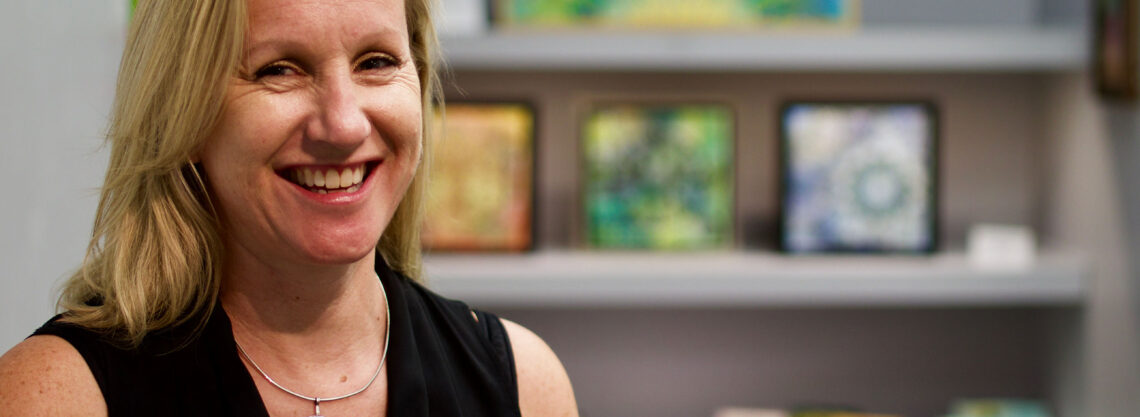Art Is for Everyone
Square Pear Gallery’s October show is called “Layers.” It celebrates texture, depth, and the simplicity and complexity of what’s revealed when artists integrate various media and perspectives to create something new. Owner Corien Siepelinga’s richly textured story reflects this theme as well. Having emigrated from Holland to Canada and then to Pennsylvania via Texas, this artist, mother of two, and former ICU nurse is happy to be settling into her home in Kennett Square, a few walkable blocks from the gallery she opened in January.
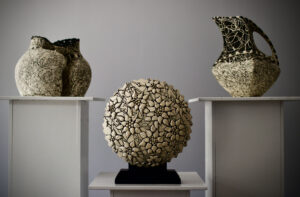
Artist: Peter Saenger
Corien Siepelinga (pronounced ko-rēnˈ sē-pa-lingˈ-a) was born in the Netherlands and moved with her family to Ontario when she was three years old. She laughs when she describes her family’s multilingual conversations. “My parents spoke Dutch, and the kids answered in English.” Though she finds the rolled Rs and Dutch gutturals difficult, she has a native’s instinct for how to employ the quintessential Canadian “eh.” She teases her son, who grew up in Texas and Pennsylvania but was born in Canada and identifies himself as Canadian, about the finer points of its usage. “You can’t just drop it in anywhere, eh,” she says with a smile.
She married John, the boy who was her elementary-school bus patrol—the couple fell in love despite the fact that both of them vowed they’d never date anyone from their close-knit Dutch Reformed community—and several years later his work with DuPont brought the young family to Victoria, Texas. There Siepelinga found herself standing on the cracked parched earth of big oil country, surrounded by tumbleweeds with two young children and a case of culture shock. The local library, in Victoria and later in Orange, Texas, was their lifeline. A trained nurse, Siepelinga wasn’t able to work until she received a work visa. So she found books and taught herself to draw. Drawing in the evenings gave her something to focus on that was all her own, and she was surprised and encouraged by the results. “It was challenging and peaceful, and time disappeared when I worked on my drawings,” she says.

Entrance to Square Pear Fine Art Gallery
After moving to Avondale in 2005, Siepelinga studied painting with Neil Carlin and later Susan Melrath, and she also took online courses with Nicholas Wilton. When her husband’s demanding travel itinerary made working hospital shifts increasingly difficult, Siepelinga spent a year devoting herself to painting in her home studio. She found it isolating and realized she needed a balance. “But what would I do?” she asked her husband one day last fall. Two days later, she brought some of her work to Stella Scott at Mala Galleria. When Scott broke the news that she was moving and selling the business, owning a gallery was the last thing on Siepelinga’s mind.
Siepelinga smiles and shakes her head in wonder as she recounts the many small miracles that have brought her to this new role—from the opportunity to build on the strong foundation Scott had established to the family inheritance that enabled her to purchase the gallery and even the windstorm that blew off the ageing awnings so she could replace them.
Square Pear is Easy to Say. The ‘Square’ Refers to Kennett Square, & I Love Pears & They Feature Frequently in My Work.
– CORIEN SIEPELlNGA
Art Should Be Accessible to All
“I wanted the name to reflect the accessibility—of the gallery and the art,” Siepelinga says. “Square Pear is easy to say. The ‘square’ refers to Kennett Square, and I love pears and they feature frequently in my work.” She and her black lab Shayla welcome visitors, artists, and friends, and Siepelinga’s smile and easygoing manner make everyone feel comfortable—whether or not they know anything about art or intend to purchase anything. “Art shouldn’t be intimidating. Only a few people can afford to spend a thousand dollars on a painting,” she says, “but art is for everyone.” Square Pear offers beautiful items at many different price points—including pottery, jewelry, and cards. But most of all, Siepelinga says, “I want people to come in and enjoy the art and appreciate what artists spend their time creating. I want people to see something new, or see something familiar in a new way, to make associations with the emotions and memories they bring to each piece.”
Art Shouldn’t Be Intimidating. Only a Few People Can Afford to Spend a Thousand Dollars on a Painting …But Art is for Everyone.
– CORIEN SIEPELlNGA
Siepelinga is committed to showcasing and supporting local artists. On a recent trip to Santa Fe with her husband to celebrate their twenty-fifth anniversary, she was expecting to be overawed by the standard of art in the galleries there. Instead, she was impressed to find that the excellence of Chester County artists was on a par with what she found in this city famed for its art scene. While it’s a challenge to mount a new show every month, Siepelinga is dedicated to presenting fresh work for the community to enjoy.
The Art of Seeing
“People can get lost in what others think they should like,” Siepelinga says, “but you like what you like.” Some may not have the training or technical vocabulary to articulate what it is that makes a piece work for them, but everyone has an innate sense of composition and balance, and a piece of art “either speaks to you or not.”
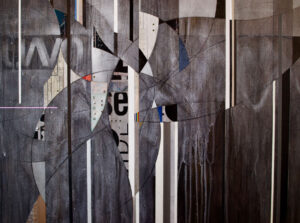
Artist: Woody Patterson
Holding a tiny painting by Kathryn E. Noska, Siepelinga demonstrates the joy of looking. A vibrant green tree frog peeks out from inside the frame, and Siepelinga points out the sacred geometry that the artist has employed to bring balance to the piece. But there’s more. “In each of these paintings there’s a path back into the piece,” she says. And it’s true. Each six-inch-square panel contains an infinite landscape, an invitation to follow the artist deeper into the heart of her vision.
Siepelinga exudes infectious enthusiasm as she walks through the gallery, pointing out extraordinary uses of color, perspective, technique, and unusual materials. She’s passionate about telling each individual artist’s story, but she also brings artists together to tell a larger story through each month’s theme. The key, she says, is striking the balance between maintaining the flow and presenting different kinds of art so each show is an adventure.
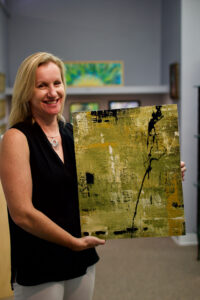
Corien Siepelinga Showing One of Her Own Pieces at Square Pear Gallery
Visitors to Square Pear will find some of Siepelinga’s own work on display too, including a new piece that reflects the layers of her own journey as an artist as well as, of course, some pears. “Currently I have two very different kinds of artwork that I do—classical realism with oil paints, and abstract painting with acrylic paints,” she says. In addition to Mala Galleria, her work has been shown at Strodes Mill Gallery, Hard Castle Gallery, and Station Gallery. While she hasn’t had time for her own painting or drawing since taking over the gallery in January, she’s looking forward to having that opportunity and to bringing the inspiration she’s gathered from other artists back to her own work.
“Having the gallery also requires a lot of creativity though,” she says. “I spend a lot of time looking at all kinds of art, going to art shows, and meeting artists. It’s interesting to hear the different ways that artists go about doing their work. Hanging the shows also requires a lot of thought and creativity, to get different kinds of art and the work of various artists to fit together in a peaceful and inviting way. It’s a different kind of art.”
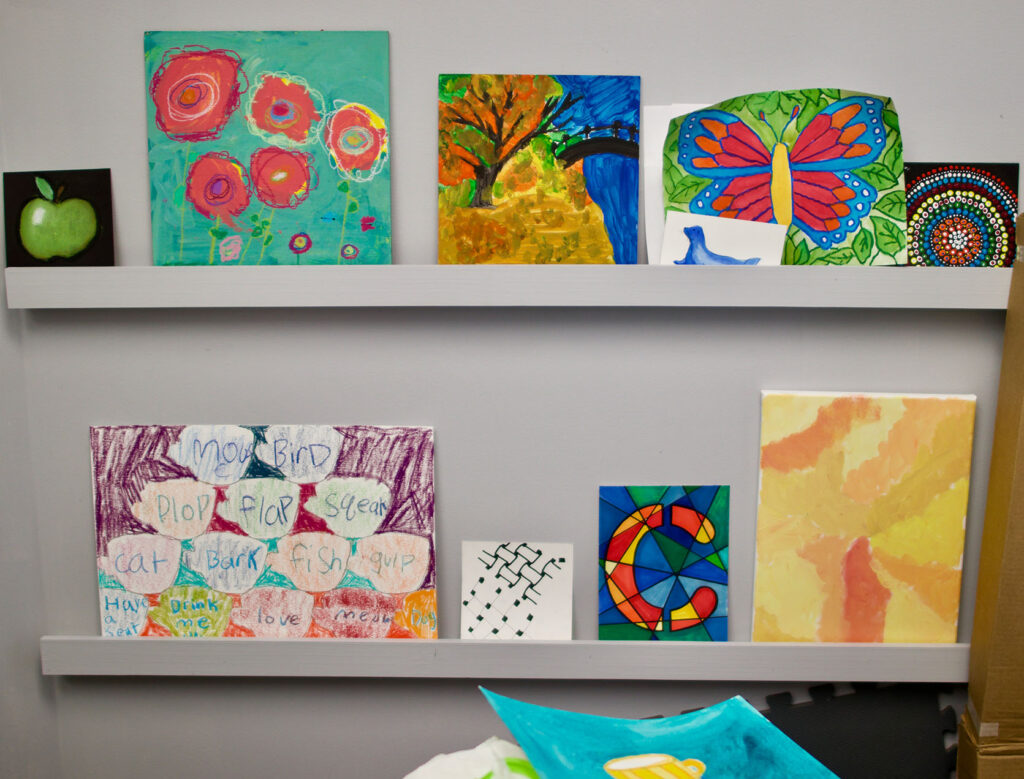
Square Pear Kids Teaches Classes to a Younger Generation of Artists
A New Generation of Local Artists
Siepelinga also loves nurturing the creativity of young artists in the classes she teaches for elementary-school children in the studio space at Square Pear. She wants to instill confidence, she says, “so they feel like they can make stuff they’re proud of.” Each week, she introduces a new project to inspire her students to create and communicate their unique visions of the world in various media.
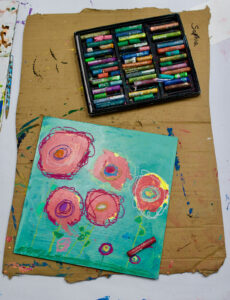
A Piece Created in a Square Pear Kids Class
Her students dive into each project eagerly, and she enjoys their chat about topics as varied as the tooth fairy, mermaid teeth, and whether or not air-dry clay actually takes “100 years” to dry. Many funny moments have reminded Siepelinga how literal kids this age can be. Her own children, Rachel and Joel, are both in college, and these classes bring back memories of when they were small and help to ease the empty nest transition.
Siepelinga reads aloud while the children are working, and each week they’re excited to see which books she’s found in the library. Sometimes, she says, they become so absorbed in the story she has to remind them to “paint some more.” A special window on the Broad Street side of the gallery displays pieces the children would like to share. Siepelinga’s goal to instill confidence appears to be successful. “Do you know how I know I’m a great artist?” one student asked. “Santa brought me an art set—and I didn’t even ask him!”
The gallery, the people, the creativity, and the small-town community all help Siepelinga feel at home in Kennett Square. “It feels like where I grew up,” she says. “You don’t know you miss it until it’s gone and comes back.”

Visit Square Pear Fine Art Gallery in Kennett Square, Pennsylvania
